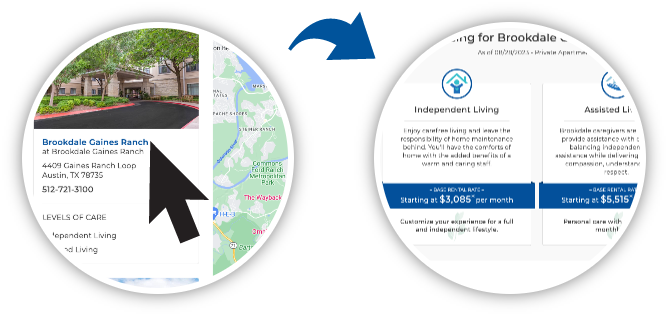- Home
- Brookdale Life
- Brookdale Blogs
- Low Vision: Impact and Interventions
Low vision is defined as vision that is 20/70 or worse and cannot be fully corrected with medication, conventional glasses or surgery. It is often characterized by partial sight such as blurred vision, blind spots or tunnel vision. New technologies and innovative intervention strategies are helping older people with various forms of low vision to adapt and overcome those challenges and are enabling them to lead more enjoyable and independent lives.
Here are the most common disorders that cause vision loss for older people:
- Age-Related Macular Degeneration (AMD): AMD is the leading cause of vision loss among Americans over 65, accounting for nearly half of all low vision cases. It is caused when the part of the eye responsible for sharp, straight-on vision – the macula – breaks down. The result is a loss of central vision.
- Diabetic Retinopathy: More than 30 percent of Americans diagnosed with diabetes have some form of diabetic retinopathy. This translates to an estimated 7.6 million Americans with the condition
- Glaucoma: With glaucoma, portions of vision are lost over time, usually with no warning signs or symptoms. For many people, a decrease in peripheral vision is the first sign of glaucoma.
- Cataracts: More than 20 million Americans have cataracts, according to Prevent Blindness America. A cataract is a clouding of the lens of the eye and causes vision to be blurry. It is one of the main causes of visual impairment among aging Americans.
All of these conditions can adversely impact the person’s ability to handle everyday tasks such self-care and bathing, meal preparation, shopping, money management, communication and leisure activities. But there is hope! These three effective intervention strategies can help improve the quality of life for those with low vision:
- Adaptive Low Vision Aids. A person with low vision typically uses multiple devices, depending on the severity of the impairment and the individual’s lifestyle. Here are some examples.
- Optical handheld magnifier: great for reading the small print on pill bottles and in recipes, for example.
- Handheld monocular telescope: can be used selectively and is portable.
- Mounted monocular telescope: spectacle-mounted telescope can be attached to the lens of one’s eyeglasses
- Assistive Technology. Some of the most common and effective technologies include:
- Lighting and glare control tools to optimize visual abilities.
- Contrast modification technologies to enhance activity background and safety.
- Visual field training aids/devices to compensate for central and or peripheral visual loss.
- Video magnification devices now include features that interface with a computer allowing the older person to read text, store pictures, and navigate various online features.
- Environmental Modification. This intervention focuses on adapting the person’s environment to make it easier for them to manage their low vision and still handle everyday tasks. These include:
- Organizing work areas and reducing clutter.
- Developing organizational systems to provide design simplicity and consistency.
- Providing safety enhancements such as non-skid mats, built-up handles and improved lighting in key areas such as the bathroom and work areas.
These environmental modifications combined with low vision tools and technologies that are more powerful, smaller and affordable than ever and are helping older people with low vision live better and with more independence. With a wide range of products on the market, from magnification to daily living aids, individuals with any type of vision loss or impairment can experience a positive outcome.
The above content is shared for educational purposes only. You must consult your doctor before acting on any content on this website, especially if you have a medical condition. The content is not intended to be a substitute for professional medical advice, diagnosis, or treatment. Never disregard professional medical advice or delay in seeking it because of something you have read on our site.
Categories
- Alzheimer's & Dementia
- Caregiver's Corner
- COVID-19
- Health, Safety and Wellness
- Financial Well-Being
- Passion & Purpose
- The Journey to Senior Living
- Trending Now
- Socialization & Relationships
- Brookdale Solutions
- Brookdale Vision and Growth
Archives
View All
- October 2025
- September 2025
- August 2025
- July 2025
- June 2025
- May 2025
- April 2025
- March 2025
- February 2025
- January 2025
- December 2024
- November 2024
X
Let us help find the right community for you!
Complete the form and a Senior Living Advisor will be in touch!
Inside Brookdale Communities
See what’s happening on our community Instagram pages
Brookdale has communities near you!



